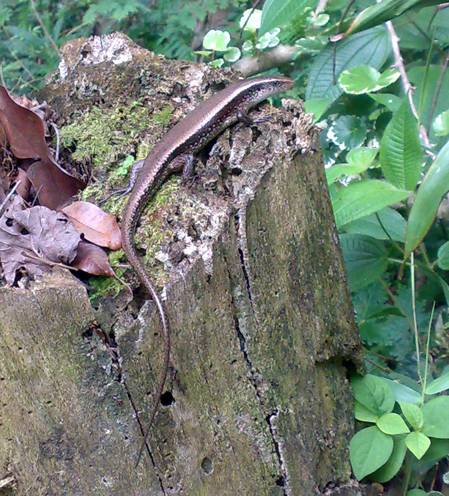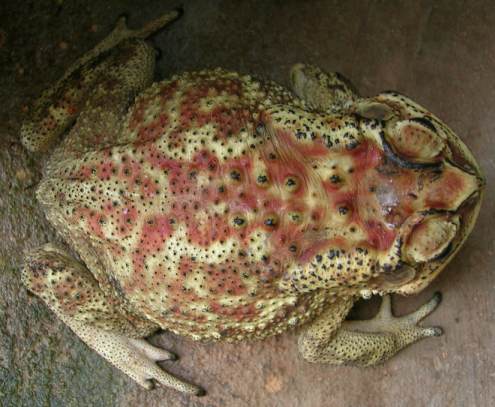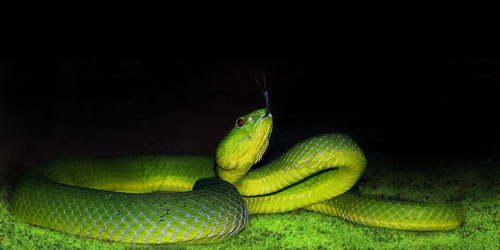Herping for amphibians and reptiles in Malaysia.
West Malaysia is part of the country of Malaysia, which also includes Sabah and Sarawak (both of which are on the island of Borneo). From a herpetological point of view, the tropical countries of Southeast Asia may not be as rich as those of Latin America, but they are home to several unique species. These include many endemic genera of frogs, lizards and snakes and even a few endemic families, such as the pipe snakes, Cylindropheidae and Anomochilidae.
Herpetological vacations in some Southeast Asian countries can turn into full-scale expeditions, owing to poor infrastructure. This does not apply to West Malaysia, which has a good network of paved roads providing access to most parts of the peninsula.
Several coastal locations and offshore islands are geared up for tourism. This obviously helps when it comes to finding accommodations and getting around, although the downside is the increased cost, compared with other countries in the region, and development, much of which is unsightly and at odds with the natural riches of the region.
Along West Malaysia's east coast and in the central mountains, the northeastern monsoon season begins at the end of September and continues in earnest throughout early October, bringing out a good variety of amphibians and reptiles that are otherwise hard to find. For this reason, autumn is the most productive time to visit the country, even though conditions can make collecting and traveling difficult at times. Methods of herping in West Malaysia are similar to those used successfully in other parts of the world: daytime and nighttime hunting along forest paths using head-flashlights, and nighttime hunting along quiet roads by motor car.
Our journey started, like that of most visitors, in the capital, Kuala Lumpur. This really is where colonial Asia meets modern Asia, as seen in the extraordinary contrast between the older style colonial buildings and the ultra-modern high-rise office blocks, which include the world's tallest building, the Petronas twin towers.
Templer Park in Malaysia
Despite the wall-to-wall humanity that characterizes most Asian cities, it proved quite easy to leave the city behind and explore some of the more natural wonders of Malaysia. A one-hour drive, for instance, took us to Templer Park, a nature reserve north of the city. This is hardly a park in the western sense of the word; rather, it is a large expanse of lowland rain forest that has been spared the planners' chain saws. As such, it can be very prolific and is certainly the easiest way to experience this particular habitat, which has suffered development to a far greater extent than montane rain forests, for instance.

Photo Credit: Erlend Bjørtvedt (CC-BY-SA)
We saw many Asian skinks (Mabuya multifasciata) on our trip.
An impressive number of reptiles and amphibians have been recorded here. Even in our jet-lagged state we managed to turn up a few interesting animals by walking the trail that connects the visitor center to a waterfall about 5 kilometers into the forest. We found a white-lipped ranid frog, Rana chalconata, resting on a bed of dead leaves a few meters from a small forest stream, a monitor, Varanus bengalensis nebulosus, many common Asian skinks, Mabuya multifasciata, and a hatchling garden lizard, Calotes versicolor. On several occasions in the course of our walk we caught sight of long-tailed macaque monkeys. The area was also notable for the number of leeches lying in ambush along the trail. A nighttime visit to this park would undoubtedly have proved more productive.
Tioman Island
Our next port of call was the island of Tioman (Pulau Tioman), about 65 kilometers off the east coast of the peninsula. This island is one of the more popular holiday destinations; nevertheless, it has an impressive list of amphibians and reptiles. The best herping is achieved by taking the footpath that crosses the island at its narrowest part, joining the villages of Tekek and Juara. This path is about 5 kilometers long and can easily be covered in two to three hours-but not by herpetologists, who must examine every tree trunk and turn every log. We had trouble getting more than halfway over the mountain before it was time to turn back. Gigantic rain forest trees, draped with lianas, line the path and brightly colored birds call from the under story. Ground skinks rustle around in the leaf litter as do monitors, of which there is a large population on the island. Tree skinks can be seen on the large tree trunks but, more impressively, flying lizards, Draco, flit from tree to tree like brightly colored butterflies. Most of these are far out of reach and a pair of pocket binoculars is helpful if you want to get a good look at them. More than one species occurs on the island, although the most common seems to be Draco volans, with a bright blue gular pouch and yellowish "wings." More spectacular still are the strange cryptic agamids that appear to be more common on this island than they are on the mainland. The armored spiny lizard, Acanthosaura armata, and the chameleon agamid, Gonocephalus chameleonatus, for instance, cling motionless to thin branches and stumps and are easily overlooked. A larger relative, Gonocephalus grandis, tends to live higher up on larger tree trunks and is hard to see and even harder to capture.
We saw all these species in the course of two days exploring this trail. At a waterfall about halfway up to the central ridge we also found a small colony of Rana hosii, bright green and highly agile frogs that live along the edges of fast-flowing mountain streams and cascades. A single snake also turned up along this trail-a variable reed snake, Calamaria lumbricoidea.
The East Coast from Maran to Pulau Kapas
Back on the mainland, our circumnavigation of the peninsula continued up the East Coast with a stopover at the attractive fishing village of Marang and a visit to the offshore island of Pulau Kapas. A rainstorm brought out a variety of amphibians at Marang, including common paddy frogs, Limnonectes limnocharis, black-spined toads, Bufo melanostictus, and Asian painted frogs, Kaloula pulchra. While on Pulau Kapas we saw only a single monitor, having decided to devote most of the day to snorkeling!
Bukit Larut
The eastern coast of Malaysia is arguably the most attractive part of the peninsula, with a string of sleepy fishing villages and long sandy beaches. But, in the interests of herpetology, we soon left it behind to cross the mountainous north of the country on the way to our next destination, the old colonial hill station, Maxwell Hill, now renamed Bukit Larut. This hill station, along with several others, was originally set up to provide a welcome relief from the oppressive heat and humidity of the lowlands, especially along the West Coast, where most of the large cities are.
Bukit Larut is reached via a steep and narrow 12-kilometer road that starts on the outskirts of the bustling city of Taiping and rises to just over 1,000 meters through a continuous series of hairpin bends. Access is restricted to government-owned Land Rovers or by foot. The upper section of the hill is covered with montane rain forest. Tree ferns, Cyathea species, are significant and attractive elements.

Photo Credit: L. Shyamal/ikimedia
Bufo melanostictus.
Bukit Larut is the wettest place on the peninsula, with an average of 198 inches per annum-I think that most of this fell in the four days we were there! In fact, a fierce storm brought down several trees during our second night, preventing vehicle access to the upper section of the road where we were based, and cutting off electricity for 12 hours.
Despite these hitches, Bukit Larut turned out to be West Malaysia's most productive site for us. Nighttime walks up and down the small mountain road led to the discovery of numerous small tree frogs, mostly Philautus vermicularis, which occurs in a variety of color forms. A few of the calling frogs proved impossible to track down through the thick vegetation. In addition to the Philautus, we also found a small tree toad, Ansonia malayana, and some attractive geckos, notably the boldly banded Cyrtodactylus pulchellus. An interesting species of naked-finger gecko, Cnemaspis, was found, but has so far proven hard to identify with certainty. Members of this genus are unusual among geckos with their round pupils and, as their name suggests, absence of toe pads.
The most exciting find was a Pope's pit viper (Trimeresurus popeorum), glimpsed through the vines one night as our flashlight picked out part of its bright green body. Disentangling it from the vegetation among which it rested proved to be interesting. I was forced to work one-handed while balancing on a steep and slippery slope. Eventually we bagged it, however, and were able to examine and photograph it at our leisure the following day. Immediately after finding the viper we caught a montane slug-eating snake, Pareas vertebralis, lying motionless, and therefore hard to see, along a thin vine. A good find at any other time, its capture was something of an anti-climax after the viper.

Photo credit: sp. Herp/Wikimedia
One of the most exciting finds was a Pope's pit viper (Trimeresurus popeorum), glimsped through the vines one night.
A fitting finale to our stay at Bukit Larut was the capture of a Malayan blue coral snake as we set out to photograph the pit viper the following morning. This snake is outrageously colorful, with a light and dark blue body, bright orange underside and orange head and tail. It belongs to the cobra family but is inoffensive and was very easy to pose and photograph. In addition to the reptiles and amphibians mentioned, we found a wealth of other interesting flora and fauna at Bukit Larut, notably several spectacular insects. A stay at the hill station is wholeheartedly recommended.
Cameron Highlands
Further south, the Cameron Highlands is the best known of the former colonial hill stations, situated north of Kuala Lumpur at an altitude of 1,300 to 1,800 meters. There is a long list of species that can potentially be found here but, on this occasion, reptiles and amphibians were most notable by their absence. Large-scale development has made access to unspoiled areas relatively difficult compared with a previous visit I made in 1985, when the area proved very productive. There are a number of rain forest trails (jungle walks) that can be followed. This would certainly be very worthwhile, especially if they were walked at night. A small road from the village of Brinchang leads to a mountain peak of the same name, Gunung Brinchang. This is the highest point that can be reached by vehicle in the peninsula. The views from this point looking west are dramatic as hundreds of acres of pristine rain forest are visible stretching into the distance. Turn 180 degrees, however, and in the middle distance you will see the less attractive face of Malaysia's rush toward the 21st century-a mess of land clearance and development with no regard for the beauty and value of the forest it replaced.
Bukit Fraser
The final hill station for us was Bukit Fraser (Fraser's Hill), 103 kilometers north of Kuala Lumpur and located at an altitude of about 1,500 meters. It also dates from colonial times and, because it is close to Kuala Lumpur, is popular with the wealthier Malaysians, especially on weekends. There is even a golf course! More relevant, there are several kilometers of walking trails around the village, mostly through fragmented, but relatively unspoiled, rain forest. Most of our hunting, however, was carried out by car. The drive from Bukit Fraser down to the main road is very narrow and one-way, with up and down traffic alternating according to the hour of the day. This road, and the main road at the bottom of the hill, is fairly quiet at night. We found a number of frogs, including a huge Rana doriae and a tiny tree-hole frog, Metaphrynella pollicaris, as well as a bent-toed gecko, Cyrtodactylus quadrivirgata and a recently DOR vine snake, Ahaetulla prasina, among other species. A nighttime jungle walk (in the rain) produced a number of spiny toads, Bufo asper, a large and attractive species that seems quite common throughout the peninsula.
Kuala Selangor
Our circuit of the peninsula was completed as we drove south from Bukit Fraser to Kuala Lumpur. We had one spare day, however, which we spent at the coastal nature reserve of Kuala Selangor, about 60 kilometers to the west of Kuala Lumpur. This reserve consists of a large expanse of mangrove forest backed by lagoons and lowland forest. It is of most interest to birders because a number of rare species and migrants occur here. Water monitors, Varanus salvator, were also quite numerous, as were the "almost-amphibian" mudskippers, Periophthalmus. With more time, we could certainly find other interesting species in this hot, humid and well-run nature reserve and this, of course, gives us a good reason for a return visit to Malaysia.


